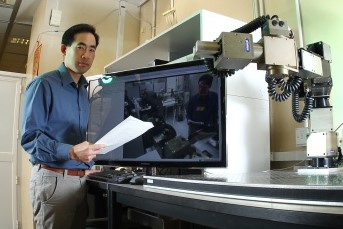Where Robotics Meets Neuroscience


If a robot had the capacity to teach itself and adapt, much like a child, it would be much more powerful than a machine that is taught explicitly what to do. Prof Bertram Shi is trying to do just that - designing neurally inspired robots that can develop, learn and adapt with the efficiency that nature intended.
To do this, Prof Shi has developed the Active Efficient Coding (AEC) framework in collaboration with Prof Jochen Triesch’s team at the Frankfurt Institute for Advanced Studies in Germany. Combining multidisciplinary talents involving math, engineering, and neural science, their framework provides a parsimonious account of the perceptual and behavioral mechanisms of animals and humans co-develop during infancy. It hypothesizes that humans adapt their neural and motor systems to facilitate the efficient encoding of relevant sensory signals during the perception-action cycle. Such neurally-inspired designs will enable robots to become more adaptive and autonomous, like biological systems they are modeled after. This technology has wide ranging applications in areas such as medicine (e.g. in predicting the effect of interventions) and industry (e.g. greater automation in manufacturing).
Perhaps nature’s design is best after all.
Prof Bertram Shi is a Professor at the Department of Electronic & Computer Engineering at HKUST. His research interests lie in the areas of neuromorphic engineering, robotics, human-machine interfaces, computational neuroscience, with a particular focus on the use of machine learning in visual information processing and visually guided control. He was named IEEE Fellow "for contributions to the analysis, implementation and application of cellular neural networks" in 2001. He was named a Distinguished Lecturer for the IEEE Circuits and Systems Society for 2001-2002 and 2007-2008. His research group's entry won the 2017 Facial Expression Recognition and Analysis (FERA) AU Intensity Estimation Challenge. Two of his papers have received top paper prizes at international conferences. He is or has been an Associate Editor for IEEE Transactions on Circuits and Systems I and II, the IEEE Transactions on Biomedical Circuits and Systems and Frontiers in Neuromorphic Engineering. He was a Chair of the IEEE Circuits and Systems Society Technical Committee on Cellular Neural Networks and Array Computing from 2003-2005. He was Technical Program Chair of the 2004 IEEE International Workshop on Cellular Neural Networks and their Applications, and General Chair of the 2005 IEEE International Workshop on Cellular Neural Networks and their Applications.